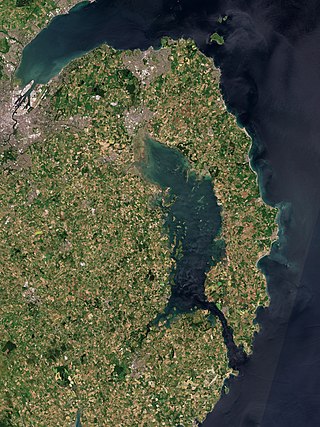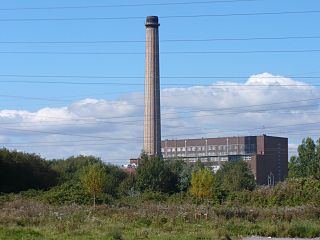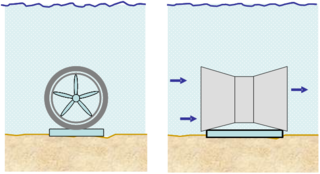
Strangford Lough is a large sea lough or inlet in County Down, in the east of Northern Ireland. It is the largest inlet in Ireland and the wider British Isles, covering 150 km2 (58 sq mi). The lough is almost fully enclosed by the Ards Peninsula and is linked to the Irish Sea by a long narrow channel at its southeastern edge. The main body of the lough has at least seventy islands along with many islets (pladdies), bays, coves, headlands and mudflats. It is part of the Strangford and Lecale Area of Outstanding Natural Beauty. Strangford Lough was designated as Northern Ireland's first Marine Conservation Zone in 2013, and has been designated a Special Area of Conservation for its important wildlife.

Tidal power or tidal energy is harnessed by converting energy from tides into useful forms of power, mainly electricity using various methods.

Portaferry is a small town in County Down, Northern Ireland, at the southern end of the Ards Peninsula, near the Narrows at the entrance to Strangford Lough. It is home to the Exploris aquarium and is well known for the annual Gala Week Float Parade. It hosts its own small Marina, the Portaferry Marina. The Portaferry – Strangford Ferry service operates daily at 30-minute intervals between the villages of Portaferry and Strangford, less than 1500 metres apart, conveying about 500,000 passengers per annum. It had a population of 2,514 people in the 2011 Census.

Enercon GmbH is a wind turbine manufacturer based in Aurich, Lower Saxony, Germany. It has been the market leader in Germany since the mid-1990s. Enercon has production facilities in Germany, Brazil, India, Canada, Turkey and Portugal. In June 2010, Enercon announced that they would be setting up Irish headquarters in Tralee.
Marine currents can carry large amounts of water, largely driven by the tides, which are a consequence of the gravitational effects of the planetary motion of the Earth, the Moon and the Sun. Augmented flow velocities can be found where the underwater topography in straits between islands and the mainland or in shallows around headlands plays a major role in enhancing the flow velocities, resulting in appreciable kinetic energy. The Sun acts as the primary driving force, causing winds and temperature differences. Because there are only small fluctuations in current speed and stream location with minimal changes in direction, ocean currents may be suitable locations for deploying energy extraction devices such as turbines. Other effects such as regional differences in temperature and salinity and the Coriolis effect due to the rotation of the earth are also major influences. The kinetic energy of marine currents can be converted in much the same way that a wind turbine extracts energy from the wind, using various types of open-flow rotors.

The European Marine Energy Centre (EMEC) Ltd is a UKAS accredited test and research center focused on wave and tidal power development, based in the Orkney Islands, UK. The centre provides developers with the opportunity to test full-scale grid-connected prototype devices in wave and tidal conditions.
Marine Current Turbines Ltd (MCT), was a United Kingdom-based company which that developed tidal stream generators, most notably the 1.2 MW SeaGen turbine. The company was bought by the German automation company, Siemens in 2012, who later sold the company to Atlantis Resources in 2015.

The Uskmouth power stations refers to a series of two coal-fired power stations at the mouth of the River Usk in the south-east of Newport, Wales. The first of the two station, Uskmouth A power station, was built in the 1940s and demolished in 2002.

New Zealand has large ocean energy resources but does not yet generate any power from them. TVNZ reported in 2007 that over 20 wave and tidal power projects are currently under development. However, not a lot of public information is available about these projects. The Aotearoa Wave and Tidal Energy Association was established in 2006 to "promote the uptake of marine energy in New Zealand". According to their 10 February 2008 newsletter, they have 59 members. However, the association doesn't list its members.

Evopod is a unique tidal energy device being developed by a UK-based company Oceanflow Energy Ltd for generating electricity from tidal streams and ocean currents. It can operate in exposed deep water sites where severe wind and waves also make up the environment.

A tidal farm is a group of multiple tidal stream generators assembled in the same location used for production of electric power, similar to that of a wind farm. The low-voltage powerlines from the individual units are then connected to a substation, where the voltage is stepped up with the use of a transformer for distribution through a high voltage transmission system.

A tidal stream generator, often referred to as a tidal energy converter (TEC), is a machine that extracts energy from moving masses of water, in particular tides, although the term is often used in reference to machines designed to extract energy from run of river or tidal estuarine sites. Certain types of these machines function very much like underwater wind turbines, and are thus often referred to as tidal turbines. They were first conceived in the 1970s during the oil crisis.
MeyGen is a tidal stream energy plant in the North of Scotland, which is currently being constructed in a phased manner. The first phase of the project uses four 1.5 MW turbines with 16 m (52 ft) rotor diameter turbines submerged on the seabed. The project is owned and run by SIMEC Atlantis Energy, although previously by Tidal Power Scotland Limited and Scottish Enterprise. Meygen was claimed to be the "world’s largest tidal stream power project".

SIMEC Atlantis Energy is a renewable energy company. It is incorporated in Singapore, but its operational headquarters are in Edinburgh, Scotland, United Kingdom. Initially, it was a developer of the tidal power turbines and projects, but after becoming a part of GFG Alliance it has expanded its business also to the waste-to-energy and hydropower.

Orbital Marine Power is a Scottish renewable energy company focused on the development and global deployment of its pioneering floating turbine technology. The O2 is Orbital's first commercial turbine and represents the culmination of more than 15 years of world leading product development in the UK. The 74 m long turbine is expected to operate in the waters off Orkney for the next 15–20 years with the capacity to meet the annual electricity demand of around 2,000 UK homes with clean, predictable power from the fast-flowing waters while offsetting approximately 2,200 tonnes of CO2 production per year. In a further ground-breaking element of the project, the O2 will provide power to the European Marine Energy Centre's onshore electrolyser to generate green hydrogen that will be used to demonstrate decarbonisation of wider energy requirements.
Many tidal stream generators have been developed over the years to harness the power of tidal currents flowing around coastlines. These are also called tidal stream turbines (TST), tidal energy converters (TEC), or marine hydro-kinetic (MHK) generation. These turbines operate on a similar principle to wind turbines, but are designed to work in a fluid approximately 800 times more dense than air which is moving at a slower velocity. Note that tidal barrages or lagoons operate on a different principle, generating power by impounding the rising and falling tide.

OpenHydro Group Ltd was an Irish developer of tidal stream turbines, established in 2004. It was acquired by Naval Energies in 2013, however, Naval Energies decided in July 2018 to stop developing tidal turbines and focus on floating wind turbines. The company subsequently went into liquidation with debts of about €280m.















